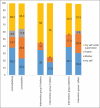Effect of oral health education based on COM-B model on improving the oral health behavior of preschool children
- PMID: 40575500
- PMCID: PMC12199998
- DOI: 10.4103/jehp.jehp_655_24
Effect of oral health education based on COM-B model on improving the oral health behavior of preschool children
Abstract
Background: The responsibility of brushing teeth in preschool children lies with the parents. The aim of this study was to determine the effect of an educational package on brushing habits and gum health in children aged 4-6.
Materials and methods: This clinical controlled trial was conducted in three kindergartens located in Isfahan during the 2022-2023. The educational intervention was designed and implemented based on the COM-B behavioral model. Group I received animation, an educational video, and reminders; group II just got educational video; and the control group received no intervention. Before and one month after the intervention, plaque index, and gingival index were recorded. To evaluate the impact of interventions on the children's toothbrushing behavior, parents were given a toothbrushing checklist and a self-assessment COM-B checklist consisted of six questions based on the VAS index. Data were analyzed using SPSS (α = 0.05).
Results: Among the study participants (91 individuals), data from 62 individuals were finally completed. In intervention group I, COM-B scores were significantly increased in terms of motivation (14.4 ± 3.4 vs. 16.1 ± 3.3, P = 0.04) and capability (15 ± 3.3 vs. 16.9 ± 3.6, P = 0.03). Improvement in plaque index was more noticeable in intervention group I (11.2 ± 6.4 vs. 6.9 ± 2.3, P value < 0.001), especially in girls. Brushing at least once a day and the direct involvement of parents in brushing were improved significantly. The GI changed nonsignificantly.
Conclusion: The designed oral health educational package was successful in improving the plaque index and some domains of COM-B among parents. This model might be promising to be used in kindergartens.
Keywords: COM-B; educational animation; gingival index; oral health education; plaque index.
Copyright: © 2025 Journal of Education and Health Promotion.
Conflict of interest statement
There are no conflicts of interest.
Figures




Similar articles
-
Chlorhexidine mouthrinse as an adjunctive treatment for gingival health.Cochrane Database Syst Rev. 2017 Mar 31;3(3):CD008676. doi: 10.1002/14651858.CD008676.pub2. Cochrane Database Syst Rev. 2017. PMID: 28362061 Free PMC article.
-
WITHDRAWN: Community-based population-level interventions for promoting child oral health.Cochrane Database Syst Rev. 2016 Dec 22;12(12):CD009837. doi: 10.1002/14651858.CD009837.pub3. Cochrane Database Syst Rev. 2016. PMID: 28004389 Free PMC article.
-
Effectiveness and tolerability of pharmacologic and combined interventions for reducing injection pain during routine childhood immunizations: systematic review and meta-analyses.Clin Ther. 2009;31 Suppl 2:S104-51. doi: 10.1016/j.clinthera.2009.08.001. Clin Ther. 2009. PMID: 19781433
-
School-based education programmes for the prevention of unintentional injuries in children and young people.Cochrane Database Syst Rev. 2016 Dec 27;12(12):CD010246. doi: 10.1002/14651858.CD010246.pub2. Cochrane Database Syst Rev. 2016. PMID: 28026877 Free PMC article.
-
Education support services for improving school engagement and academic performance of children and adolescents with a chronic health condition.Cochrane Database Syst Rev. 2023 Feb 8;2(2):CD011538. doi: 10.1002/14651858.CD011538.pub2. Cochrane Database Syst Rev. 2023. PMID: 36752365 Free PMC article.
References
-
- Asgari I GN. The association between caries in primary teeth and permanent molars’ health in 9 years old children. JDM. 2017;30:97–103. (In Persian)
-
- Abouie A, Majdzadeh R, Khabiri R, Hamedi-Shahraki S, Emami Razavi SH, Yekaninejad MS. Socioeconomic inequities in health services’ utilization following the Health Transformation Plan initiative in Iran. Health Policy Plan. 2018;33:1065–72. - PubMed
-
- Whittal A, Störk S, Riegel B, Herber OR. Applying the COM-B behaviour model to overcome barriers to heart failure self-care: A practical application of a conceptual framework for the development of complex interventions (ACHIEVE study) Eur J Cardiovasc Nurs. 2021;20:261–7. - PubMed
LinkOut - more resources
Full Text Sources

